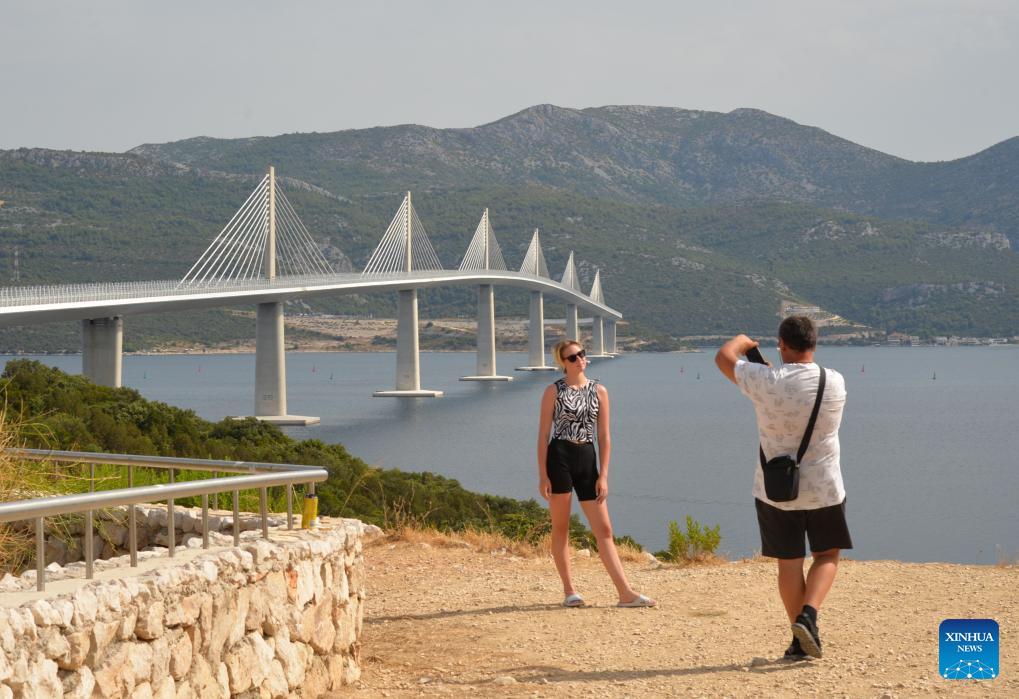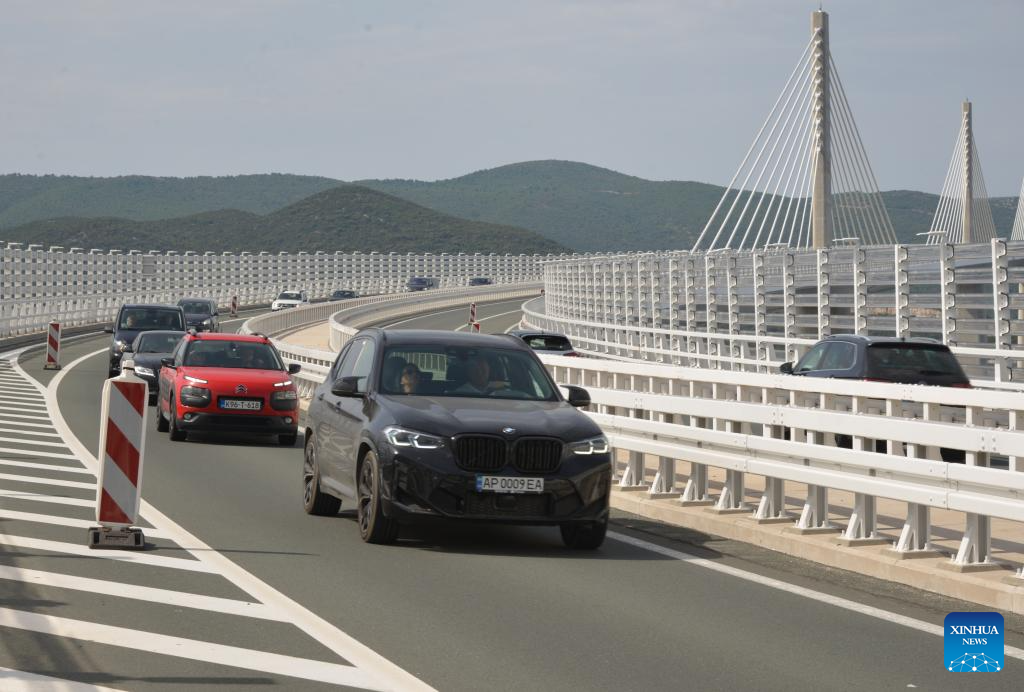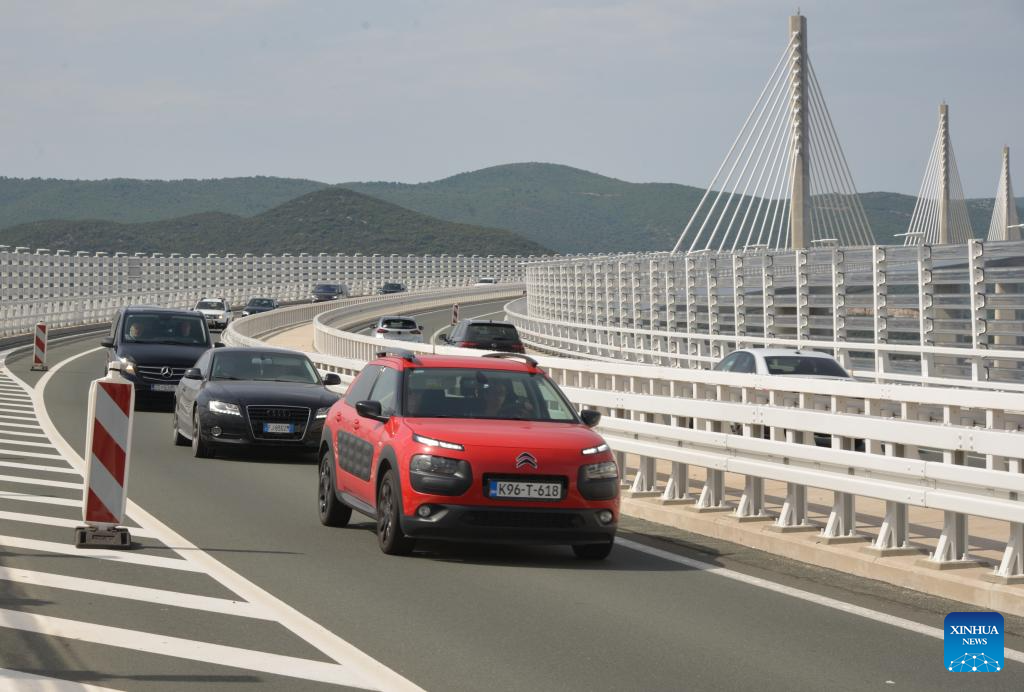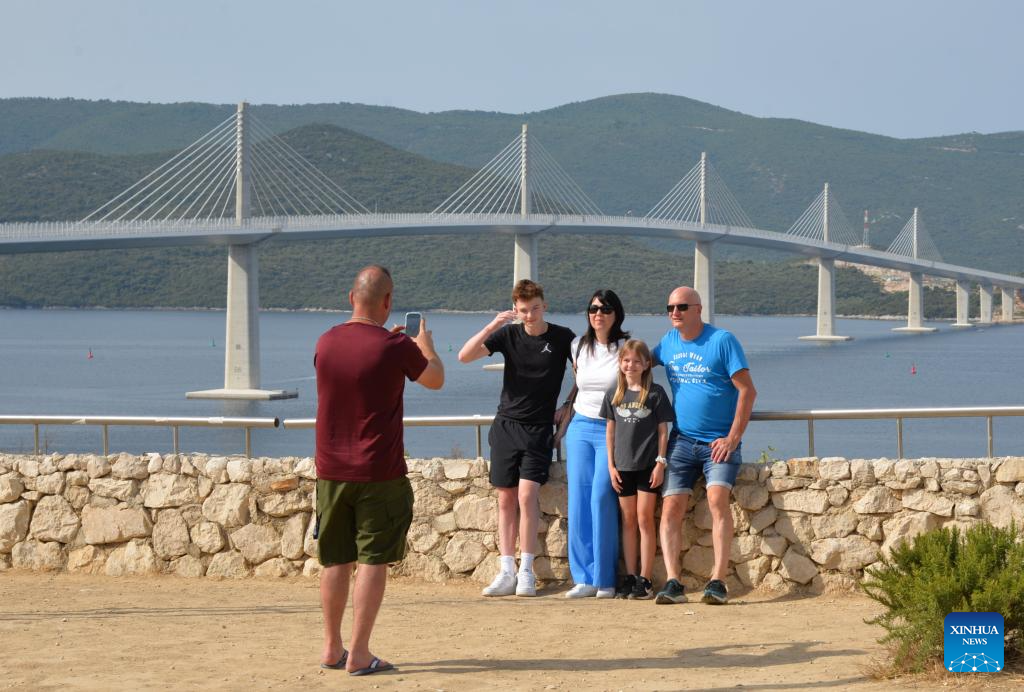Feature: Croatians give thumbs up to Chinese-built Peljesac Bridge
Source: Xinhua
Editor: huaxia
2025-07-26 19:03:15

A woman poses for photos with the Peljesac Bridge in Komarna, Croatia on July 26, 2025. (Xinhua/Li Xuejun)
KOMARNA, Croatia, July 26 (Xinhua) -- On the third anniversary of the official opening of the Peljesac Bridge on the southern Adriatic coast of Croatia, Croatians from all walks of life have given their thumbs up to the Chinese builders and the Chinese-built bridge.
The 2.4-km-long Peljesac Bridge was constructed by a Chinese consortium led by the China Road and Bridge Corporation (CRBC) and was mainly funded by the European Union (EU).
Ever since its inauguration on July 26, 2022, the bridge has significantly improved people's lives, facilitated traffic and transportation, cut travel time to the Adriatic coast and increased economic opportunities for the region.
Croatian Prime Minister Andrej Plenkovic, who had visited the construction site of the bridge six times before its opening, has hailed it as an example of bilateral cooperation between Croatia and China.
According to Goran Legac, project director at the Croatian Roads, the state-run road operator, more than 7 million vehicles have passed through the bridge amid the third anniversary of its inauguration.
The bridge has brought numerous benefits, including faster and easier traffic, improved flow of goods, services and people, Legac told Xinhua, hailing the cooperation with the Chinese side.
"I would like to give my thumbs up to the Chinese workers, who did an excellent job. They were exceptionally hardworking, and they are truly worthy of respect," Ivana Dragobratovic, a local resident who lives near the bridge and rents out apartments to tourists, told Xinhua.
Dragobratovic said that before the bridge was built, she could only do business during the summer season as there were few residents or tourists in the region during winter. However, the bridge has changed all this as it brings tourists even in winter months, and now she can do business all year round.
"I want to thank the Chinese workers for building the bridge, for bringing more visitors to my apartments," she said.
Dragobratovic was echoed by Antonio Mikulic, a local hotel operator near the Peljesac Bridge.
"Before the bridge was built, it used to be basically empty here during winter: there were few people around, almost everything was closed," Mikulic told Xinhua, adding that in comparison, hotels and restaurants are now open all year long.
Mikulic said that a majority of the visitors came to visit the region thanks to the bridge.
"They tell me that without the bridge, probably 70 percent of them would not have come. They say the bridge is beautiful, it looks stunning," he said.
As to Andro Crvik, owner of a winery from Konavle near Dubrovnik, he credited the Peljesac Bridge for the benefits to his winery as well as the local people.
"Faster communication always means easier and better business," he said, adding that the sales of his winery have increased markedly as the bridge has enabled wines to be transported much more quickly and timely to other parts of Croatia, resulting in more wine sales.
Before the bridge was built, the wine of his winery, located in Dubrovnik, had to be shipped to other parts of Croatia via the Neum Corridor in Bosnia and Herzegovina (BiH) and go through the cumbersome exit and entry procedures which often took two to three hours. In sharp contrast, after the bridge was built, it now takes only two to three minutes, Crvik noted.
The bridge, which reaches across the Mali Ston Bay and connects the Croatian mainland with the Peljesac Peninsula for the first time in the Croatian history, also means that the tourists and logistics drivers from the Croatian mainland no longer have to detour through the Neum Corridor in BiH to go to Dubrovnik, Korcula, and other cities in southern Croatia.
Vedran Antunica, mayor of Ston Municipality in the Dubrovnik-Neretva County administrating the Peljesac Bridge, told Xinhua that since the bridge was built, life in the region has improved "drastically."
The bridge has attracted more and more visitors, leading to booming business of restaurants and hotels, Antunica said, adding that as a notable economic effect of the bridge, a big market center was recently opened in Ston.
"The bridge has brought significant benefits to the Ston city and the region," Antunica said.
In the eyes of Ana Vulic, who used to be an employee at the Peljesac Bridge project from 2018-2022, the Chinese colleagues have proved themselves to be hardworking, highly professional and capable, as the project was successfully completed in time despite the COVID-19 pandemic.
"Now if there is a tender for a new infrastructure project in Croatia, people will always say, let the CRBC do it, let the Chinese do it," she told Xinhua.
For Branko Losic, an architect from Dubrovnik, he could not agree more with Vulic.
"I believe the excellent cooperation on the Peljesac Bridge should be an example and the cooperation between Croatia and China should continue. I hope the Chinese builders can get more such large projects in Croatia," Losic told Xinhua. ■

Vehicles run on the Peljesac Bridge in Komarna, Croatia on July 26, 2025. (Xinhua/Li Xuejun)

Vehicles run on the Peljesac Bridge in Komarna, Croatia on July 26, 2025. (Xinhua/Li Xuejun)

Visitors pose for photos with the Peljesac Bridge in Komarna, Croatia on July 26, 2025. (Xinhua/Li Xuejun)



